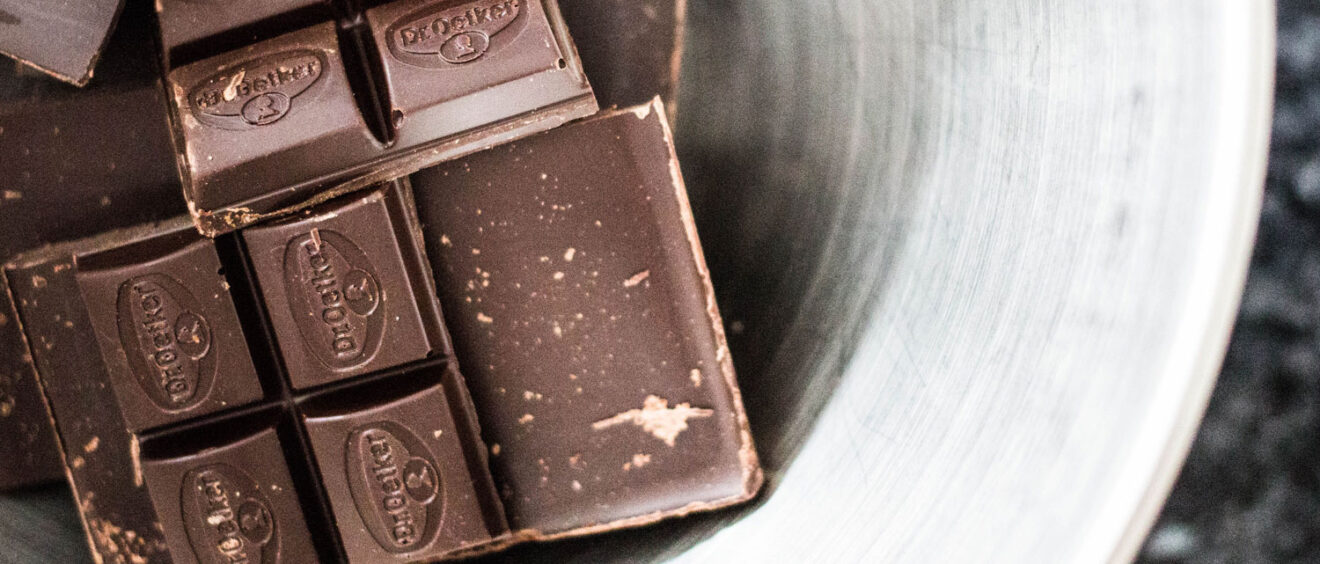
Guilt Free Chocolate For all You Romantics this weekend!!
Few things go together like chocolate and Valentine’s Day. It’s true, giving and receiving chocolate has become one of the most popular ways to commemorate the day of love.
Chocolate is the ultimate comfort food, a guilty pleasure, and the good news is that the right kind of chocolate can actually be good for you. Chocolate comes from the cocoa bean, which literally means ‘food of the gods’. And, historically, chocolate was so prized, cacao seeds were used as a form of currency (and, of course, some enterprising sorts even found a way to make counterfeit cocoa). It turns out those Mayans and Aztecs knew a thing or two because modern scientific research is finding new ways in which chocolate – good quality chocolate, at least – can be worth its weight in gold when it comes to your health. The healthiest forms of chocolate are dark chocolate (70% cocoa content or higher) and cacao nibs, the original, natural form. (Just in case you are wondering, the health benefits of milk or white chocolate, and any of the processed sweetened stuff are slim to none!)
HISTORY OF CHOCOLATE
The use of chocolate dates back thousands of years. The Mayans were the first to discover its powers. They worshiped the cocoa tree and called the chocolate (or xocolatl) they created from it the ‘food of the gods’. The Mayans used it for a myriad of purposes, including making from it a ceremonial drink of ground cocoa beans, vanilla and other spices, such as chilli. Cocoa was highly valued for its healing and medicinal properties. The Mayan chocolate was very different from the chocolate we know today – not least because it contained no sugar. Spanish explorer Christopher Columbus brought cocoa beans back from his travels in the Americas in the 16th century. No one was particularly impressed, and the Spanish kept the cocoa bean to themselves for decades. Once cocoa started catching on, Spanish cooks experimented with the recipe and added sugar to sweeten it. By the 17th century, it had made its way to France and the court of king Louis XIII and, in 1615, David Chaillou was given a ‘royal authorization’ to open the first chocolaterie in Paris. In 1657, chocolate made its way to Britain. Chocolate was still enjoyed pretty much the way the Mayans made it right up until the Industrial Revolution, when the cocoa press (that could separate the cocoa butter from the powder we now call cocoa) was invented. A number of other new processes also made the chocolate creamier, smoother and tastier. The world’s first chocolate bar was created in 1847. And the rest, they say, is history.
FRUIT & NUT CHOCOLATE BARK
350g dark chocolate 125g blanched almonds, toasted and chopped 100g unsweetened dried fruit (eg cranberries or mango) pinch of sea salt.
Line a baking sheet with parchment.
Melt the dark chocolate by filling the bottom of a saucepan with couple of cms of water and bring to a simmer over a medium-high heat. Put the chocolate in a glass bowl and set over the simmering water, stirring occasionally.
Once melted, tip into the prepared tin and smooth with a spatula so the chocolate is evenly distributed. Scatter over the remaining ingredients (you can add a pinch of dried chillies if you’re feeling brave) and chill in the fridge until the chocolate sets (about 30 mins). Peel off the parchment and break into pieces. Store in an airtight container for up to a month (if it lasts that long).
LOW GL CHOCOLATE FRUIT CLUSTERS
100g dark chocolate
15g dried cranberries
25 ready to eat apricots 40g pecan nuts
5 Nairns rough oatcakes
2 tsp xylitol 40g flaked almonds
Melt the chocolate in a glass bowl set in shallow water over a low heat. Blend all ingredients (except almonds) in a food processor until roughly chopped. Add the blitzed mixture and the almonds to the melted chocolate and coat thoroughly. Spoon into 10-12 cake cases and chill in fridge until set .
CHOCOLATE & BANANA ICE CREAM
(makes 2 servings) 2 bananas, chopped and frozen
1 tbsp cocoa powder or raw cacao
Strictly speaking, this isn’t ice cream in the traditional sense, containing neither cream nor sugar. When ripe frozen bananas and cocoa powder are combined together in a blender you get a creamy, guilt-free, scrumptious frozen treat. Put the frozen bananas in a food processor and pulse until smooth. When the mixture is smooth, add the cocoa powder and blend until incorporated. For a soft ice cream, serve immediately. For a firm chocolate banana ice cream, transfer it back to the freezer for at least an hour.
RAW CHOCOLATE TART
450g cashews
2tbsp coconut oil 1tbsp espresso
Finely ground ½ tsp sea salt 4 tbsp maple syrup
85g cacao powder
245g full fat coconut milk
Combine 225g (unsoaked) cashews, coconut oil, espresso, salt and 1 tablespoon maple syrup in the food processor and blitz until finely chopped. Line an 8-inch tart tin with parchment. Press the crust mixture into the bottom using the back of a spoon and set aside. Then combine 225g of the cashews (soaked for 30 mins in boiling water), the remaining 3 tbsp maple syrup, cacao powder and coconut milk and blend in a food processor until totally smooth. Pour the filling into the crust and refrigerate for at least two hours before serving. Can also be topped with berries or bananas for a fruity twist and Enjoy, Happy Valentines day to you all.
To find out more about my programmes, you can reach me on 0874191301 or find me on Facebook SB Sports & Nutrition Therapist or log onto www.simplebalancenutrition.ie
Online Programmes available to complete from the comfort of your own home,
